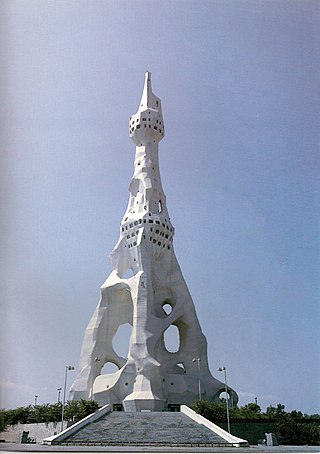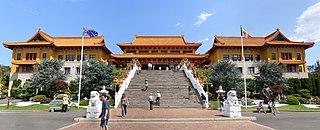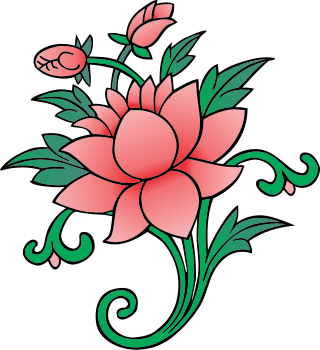
Nichiren Buddhism, also known as Hokkeshū, is a branch of Mahayana Buddhism based on the teachings of the 13th-century Japanese Buddhist priest Nichiren (1222–1282) and is one of the Kamakura period schools. Its teachings derive from some 300–400 extant letters and treatises either authored by or attributed to Nichiren.

Nichiren Shōshū is a branch of Nichiren Buddhism based on the traditionalist teachings of the 13th century Japanese Buddhist priest Nichiren (1222–1282), claiming him as its founder through his senior disciple Nikko Shonin (1246–1333), the founder of Head Temple Taiseki-ji, near Mount Fuji. The lay adherents of the sect are called Hokkeko members. The Enichizan Myohoji Temple in Los Angeles, California serves as the temple headquarters within the United States.

Soka Gakkai is a Japanese Buddhist religious movement based on the teachings of the 13th-century Japanese priest Nichiren. It claims the largest membership among Nichiren Buddhist groups.

Buddhism was first established in Japan in the 6th century CE. Most of the Japanese Buddhists belong to new schools of Buddhism which were established in the Kamakura period (1185-1333). During the Edo (Tokugawa)-period (1603–1868), Buddhism was controlled by the feudal Shogunate. The Meiji-period (1868–1912) saw a strong response against Buddhism, with persecution and a forced separation between Buddhism and Shinto.

Daisaku Ikeda was a Japanese Buddhist leader, author, philosopher, educator and businessman. He served as the third president and then honorary president of the Soka Gakkai, the largest of Japan's new religious movements. At this time, he became a controversial leader, in Japan and abroad.

The term American Buddhism can be used to describe all Buddhist groups within the United States, including Asian-American Buddhists born into the faith, who comprise the largest percentage of Buddhists in the country.

Gohonzon (御本尊) is a generic term for a venerated religious object in Japanese Buddhism. It may take the form of a scroll or statuary. The term gohonzon typically refers to the mainstream use of venerated objects within Nichiren Buddhism, referring to the calligraphic paper mandala inscribed by the 13th Japanese Buddhist priest Nichiren to which devotional chanting is directed.

With nearly 250,000 Buddhists, Brazil is home to the third-largest Buddhist population in the Americas, after the United States and Canada. Buddhism in Brazil consists of practitioners from various Buddhist traditions and schools. A number of Buddhist organisations and groups are also active in Brazil, with nearly 150 temples spread across the states.

Japanese new religions are new religious movements established in Japan. In Japanese, they are called shinshūkyō (新宗教) or shinkō shūkyō (新興宗教). Japanese scholars classify all religious organizations founded since the middle of the 19th century as "new religions"; thus, the term refers to a great diversity and number of organizations. Most came into being in the mid-to-late twentieth century and are influenced by much older traditional religions including Buddhism and Shinto. Foreign influences include Christianity, the Bible, and the writings of Nostradamus.
Religion in Iceland has been predominantly Christianity since its adoption as the state religion by the Althing under the influence of Olaf Tryggvason, the king of Norway, in 999/1000 CE. Until then, in the 9th and 10th centuries, the prevailing religion among the early Icelanders — who were mostly Norwegian settlers fleeing Harald Fairhair's monarchical centralisation in 872–930, with some Swedes and Norse British settlers — was the northern Germanic religion, which persisted for centuries even after the official Christianisation of the state.

In Australia, Buddhism is a minority religion. According to the 2021 census, 0.2 percent of the total population or 30,474 of Australia identified as Buddhist. It was also the fastest-growing religion by percentage, having increased its number of adherents by 79 percent between the 1996 and 2001 censuses. The highest percentage of Buddhists in Australia is present in Christmas Island, where Buddhists constitute 18.1% of the total population according to the 2016 Census. Buddhism is the fourth largest religion in the country after Christianity, Islam and Hinduism.

Buddhism in Italy is the third most spread religion, next to Christianity and Islam. In the country there are 358,000 Buddhists, that is to say the 0.6% of the total population.

Soka Gakkai International (SGI) is an international Nichiren Buddhist organization founded in 1975 by Daisaku Ikeda, as an umbrella organization of Soka Gakkai.
Buddhism is a minority religion in Denmark with approximately 64,000 members (1.1%) in 2018.
Minoru Harada is a Japanese Buddhist leader. He is the sixth president of the Soka Gakkai from 9 November 2006. He is also the Supreme Advisor of Sōka University and the Acting President of Soka Gakkai International (SGI).

Kōsen-rufu (広宣流布), a phrase found in the Japanese translation of the Buddhist scripture Lotus Sutra, is informally defined to as "world peace through individual happiness." It refers to the future widespread dissemination of the Lotus Sutra.
The Soka Gakkai Italian Buddhist Institute is the Italian branch of the Soka Gakkai International Nichiren Buddhist organisation. The Soka Gakkai Italian Buddhist Institute is popularly known by the acronyms SGI-Italia, SGI-Italy, and SGI-I.
Buddhism is New Zealand's third-largest religion after Christianity and Hinduism standing at 1.5% of the population of New Zealand. Buddhism originates in Asia and was introduced to New Zealand by immigrants from East Asia.
Buddhism is a minority faith in Cuba. Traditionally, most religious people in Cuba practice Christianity or other Indigenous religions. Buddhism was brought by the Chinese immigrants, and has recently seen an increase to approximately 500 practitoiners in 2024 largely due to the Soka Gakkai, a Japanese buddhist organization.













